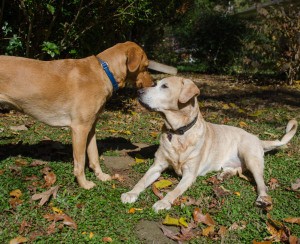Introducing Your New Dog to Your Household

So You Have a New Dog!
Introducing a new dog into a household where there is already another pet, whether a dog, cat, bird or small mammal, can be quite tricky. How to accomplish this without squabbles or bloodshed is a question often posed to animal behaviorists. The character of any new dog you plan to integrate is an important factor. Where possible, you should take into account the sex, age, breed, and past experience of any dog you plan bring home before making a commitment.The impact of obtaining a new dog can be strenuous on the other pets in the household. However, once the initial stress of introductions has passed, the new arrangement can turn out to be a happy one!
Dog to Dog Introductions
If the incumbent dog has lots of energy for playing, obtaining a puppy or young adult dog is appropriate. However, if your present dog is unlikely to tolerate the antics and energy of an adolescent dog, consider getting an older dog that will not be trying to compel your old faithful to play all the time. Don’t get upset when the resident dog tells the newcomer to “bug off.” This is how the new dog learns the house rules. A hierarchy will develop over the first few weeks, and in general, the older and incumbent dog will and should occupy the “alpha position.”Here are some tips on how to introduce two dogs: It may be possible to introduce the dogs in a relaxed manner by just letting them sniff and play – as long as both are known to be friendly with other dogs. If you are not sure how the dogs will react, start off cautiously by taking them for a walk together on neutral territory (e.g. a park, not your yard).
When they show friendly behavior toward each other or begin to ignore each other, move the exercise to your back yard. Finally, allow the dogs to be together in your home. Be aware that wagging tails do not necessarily mean that dogs are happy to see each other. A straight up tail that wags stiffly is a dominant signal. Such a display might herald aggression.
If one of the dog’s tails is tucked down between its legs, that dog is afraid and nervous. This calls for a gradual, well-supervised approach to avoid making the dog even more fearful. If a dog’s tail is horizontal and wagging in a relaxed fashion, it’s all systems go!
Don’t expect the dogs to share. Sharing isn’t normal for most dogs. Feed the dogs separately (across the room) and don’t give really delicious chew toys (rawhides, pigs’ ears) at first. Once the hierarchy is secure, you’ll probably be able to give the dogs all the chew toys they want.
Dog to Cat Introductions
Age and sex of a dog are not major concerns when adding a dog to a household where there is a cat. However, a puppy will naturally be more inclined to want to play with the cat, so if your feline will not tolerate a pushy puppy, consider an older dog. There’s an advantage, however, to adding a puppy to a cat-dominated household: the puppy will learn to tolerate or even like cats as he grows up. If you are obtaining an adult dog, find out whether the dog has a past history of living amicably with cats, or has been tested with cats. If you are looking to obtain a dog from a breed rescue or professional breeder, take special care when considering a breed that has a reputation for being aggressive to cats. Keep your new dog on a leash when introducing him to your resident cat. Try to choose a calm and relaxed moment to introduce the two. Make them feel good by feeding them delicious food and keep them at a distance from each other so that your cat will feel safe. Practice obedience exercises (sit-stays) with your dog. Let your cat initiate contact with your new dog if he chooses to do so. Never let your dog chase your cat. Always have special escape routes and high hiding places for your cat to access anytime he wants to get away. It is very important that your cat has private, safe places to escape to.
Dog to Small Mammal or Bird Introductions
Be very cautious when introducing a dog to a small mammal or bird. Some dogs have strong predatory tendencies and may be dangerous for either. Until a dog has shown disinterest in the “small ones” (this may take weeks or months to establish), do not allow him to be alone with the little critters. If your dog has strong predatory instincts (e.g. greyhounds and terriers) your smaller residents could be in a lot of danger if you do not keep them securely out of your dog’s reach. Find a safe place for your small mammal or bird to reside. The enclosure should be secure and out of the dog’s reach at all times. Keep the room where your small mammal or bird lives “off limits” unless you are strictly supervising your dog.